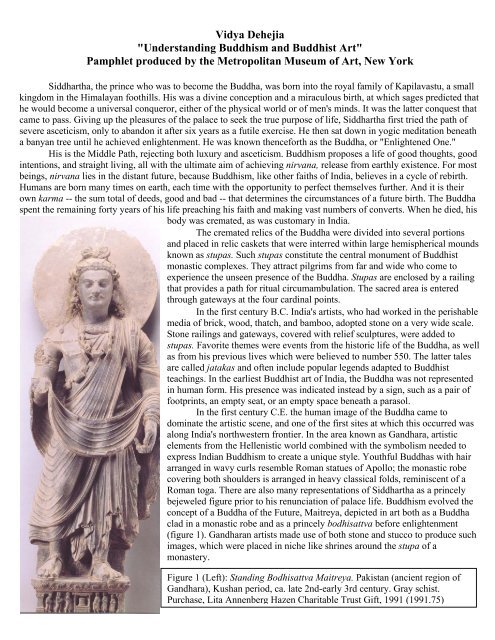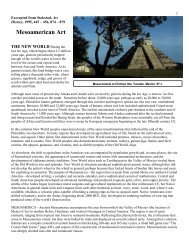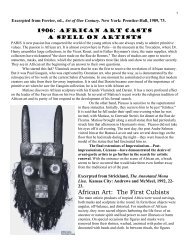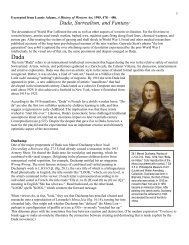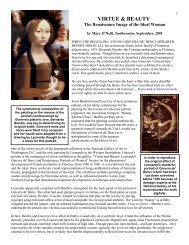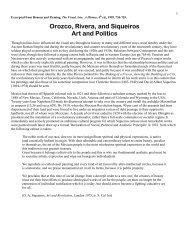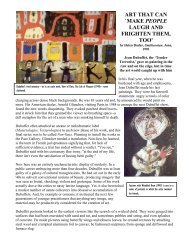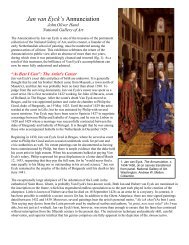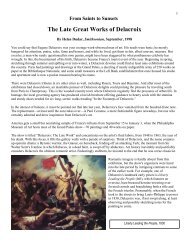Buddhism and Buddhist Art, pamphlet from Met.pdf - Phs.poteau.k12 ...
Buddhism and Buddhist Art, pamphlet from Met.pdf - Phs.poteau.k12 ...
Buddhism and Buddhist Art, pamphlet from Met.pdf - Phs.poteau.k12 ...
You also want an ePaper? Increase the reach of your titles
YUMPU automatically turns print PDFs into web optimized ePapers that Google loves.
Vidya Dehejia<br />
"Underst<strong>and</strong>ing <strong>Buddhism</strong> <strong>and</strong> <strong>Buddhist</strong> <strong>Art</strong>"<br />
Pamphlet produced by the <strong>Met</strong>ropolitan Museum of <strong>Art</strong>, New York<br />
Siddhartha, the prince who was to become the Buddha, was born into the royal family of Kapilavastu, a small<br />
kingdom in the Himalayan foothills. His was a divine conception <strong>and</strong> a miraculous birth, at which sages predicted that<br />
he would become a universal conqueror, either of the physical world or of men's minds. It was the latter conquest that<br />
came to pass. Giving up the pleasures of the palace to seek the true purpose of life, Siddhartha first tried the path of<br />
severe asceticism, only to ab<strong>and</strong>on it after six years as a futile exercise. He then sat down in yogic meditation beneath<br />
a banyan tree until he achieved enlightenment. He was known thenceforth as the Buddha, or "Enlightened One."<br />
His is the Middle Path, rejecting both luxury <strong>and</strong> asceticism. <strong>Buddhism</strong> proposes a life of good thoughts, good<br />
intentions, <strong>and</strong> straight living, all with the ultimate aim of achieving nirvana, release <strong>from</strong> earthly existence. For most<br />
beings, nirvana lies in the distant future, because <strong>Buddhism</strong>, like other faiths of India, believes in a cycle of rebirth.<br />
Humans are born many times on earth, each time with the opportunity to perfect themselves further. And it is their<br />
own karma -- the sum total of deeds, good <strong>and</strong> bad -- that determines the circumstances of a future birth. The Buddha<br />
spent the remaining forty years of his life preaching his faith <strong>and</strong> making vast numbers of converts. When he died, his<br />
body was cremated, as was customary in India.<br />
The cremated relics of the Buddha were divided into several portions<br />
<strong>and</strong> placed in relic caskets that were interred within large hemispherical mounds<br />
known as stupas. Such stupas constitute the central monument of <strong>Buddhist</strong><br />
monastic complexes. They attract pilgrims <strong>from</strong> far <strong>and</strong> wide who come to<br />
experience the unseen presence of the Buddha. Stupas are enclosed by a railing<br />
that provides a path for ritual circumambulation. The sacred area is entered<br />
through gateways at the four cardinal points.<br />
In the first century B.C. India's artists, who had worked in the perishable<br />
media of brick, wood, thatch, <strong>and</strong> bamboo, adopted stone on a very wide scale.<br />
Stone railings <strong>and</strong> gateways, covered with relief sculptures, were added to<br />
stupas. Favorite themes were events <strong>from</strong> the historic life of the Buddha, as well<br />
as <strong>from</strong> his previous lives which were believed to number 550. The latter tales<br />
are called jatakas <strong>and</strong> often include popular legends adapted to <strong>Buddhist</strong><br />
teachings. In the earliest <strong>Buddhist</strong> art of India, the Buddha was not represented<br />
in human form. His presence was indicated instead by a sign, such as a pair of<br />
footprints, an empty seat, or an empty space beneath a parasol.<br />
In the first century C.E. the human image of the Buddha came to<br />
dominate the artistic scene, <strong>and</strong> one of the first sites at which this occurred was<br />
along India's northwestern frontier. In the area known as G<strong>and</strong>hara, artistic<br />
elements <strong>from</strong> the Hellenistic world combined with the symbolism needed to<br />
express Indian <strong>Buddhism</strong> to create a unique style. Youthful Buddhas with hair<br />
arranged in wavy curls resemble Roman statues of Apollo; the monastic robe<br />
covering both shoulders is arranged in heavy classical folds, reminiscent of a<br />
Roman toga. There are also many representations of Siddhartha as a princely<br />
bejeweled figure prior to his renunciation of palace life. <strong>Buddhism</strong> evolved the<br />
concept of a Buddha of the Future, Maitreya, depicted in art both as a Buddha<br />
clad in a monastic robe <strong>and</strong> as a princely bodhisattva before enlightenment<br />
(figure 1). G<strong>and</strong>haran artists made use of both stone <strong>and</strong> stucco to produce such<br />
images, which were placed in niche like shrines around the stupa of a<br />
monastery.<br />
Figure 1 (Left): St<strong>and</strong>ing Bodhisattva Maitreya. Pakistan (ancient region of<br />
G<strong>and</strong>hara), Kushan period, ca. late 2nd-early 3rd century. Gray schist.<br />
Purchase, Lita Annenberg Hazen Charitable Trust Gift, 1991 (1991.75)
Contemporaneously, the Kushan-period artists in Mathura, India,<br />
produced a different image of the Buddha. His body was exp<strong>and</strong>ed by sacred<br />
breath (prana), <strong>and</strong> his clinging monastic robe was draped to leave the right<br />
shoulder bare.<br />
A third influential Buddha type evolved in Andhra Pradesh, in South India,<br />
where images of substantial proportions, with serious, unsmiling faces, were<br />
clad in robes that created a heavy swag at the hem <strong>and</strong> revealed the left<br />
shoulder. These southern sites provided artistic inspiration for the <strong>Buddhist</strong><br />
isl<strong>and</strong> of Sri Lanka, off the southern tip of India, <strong>and</strong> Sri Lankan monks<br />
regularly visited the area. A number of statues in this style have been found as<br />
well throughout Southeast Asia.<br />
Figure 2 (<strong>and</strong> cover): St<strong>and</strong>ing Buddha. India (Mathura), Gupta period, 5th<br />
Century. Mottled red s<strong>and</strong>stone. Purchase, Enid A. Haupt Gift, 1979.<br />
The succeeding Gupta period, <strong>from</strong> the fourth to the sixth century C.E.,<br />
in North India, sometimes referred to as a Golden Age, witnessed the creation<br />
of an "ideal image" of the Buddha (figure 2). This was achieved by combining<br />
selected traits <strong>from</strong> the G<strong>and</strong>haran region with the sensuous form created by<br />
Mathura artists.<br />
Gupta Buddhas have their hair arranged in tiny individual curls, <strong>and</strong> the<br />
robes have a network of strings to suggest drapery folds (as at Mathura) or are<br />
transparent sheaths (as at Sarnath). With their downward glance <strong>and</strong> spiritual<br />
aura, Gupta Buddhas became the model for future generations of artists,<br />
whether in post-Gupta <strong>and</strong> Pala India or in Nepal, Thail<strong>and</strong>, <strong>and</strong> Indonesia.<br />
Gupta metal images of the Buddha were also taken by pilgrims along the Silk<br />
Route into China.<br />
Over the following centuries there emerged a new<br />
form of <strong>Buddhism</strong>, which involved an exp<strong>and</strong>ed<br />
pantheon <strong>and</strong> more elaborate rituals. This later<br />
<strong>Buddhism</strong> introduced the concept of heavenly<br />
bodhisattvas as well as goddesses, of whom the<br />
most popular was Tara. In Nepal <strong>and</strong> Tibet, where<br />
exquisite metal images <strong>and</strong> paintings were<br />
produced, an entire set of new divinities was<br />
created <strong>and</strong> portrayed in both sculpture <strong>and</strong><br />
painted scrolls (figure 3). Ferocious deities were<br />
introduced in the role of protectors of <strong>Buddhism</strong><br />
<strong>and</strong> its believers. Images of a more esoteric<br />
nature, depicting god <strong>and</strong> goddess in embrace,<br />
were produced to demonstrate the metaphysical<br />
concept that salvation resulted <strong>from</strong> the union of<br />
wisdom (female) <strong>and</strong> compassion (male).<br />
<strong>Buddhism</strong> had traveled a long way <strong>from</strong> its simple<br />
beginnings. -Vidya Dehejia The <strong>Met</strong>ropolitan<br />
Museum of <strong>Art</strong><br />
Figure 3 (left): The Buddha<br />
Amoghasiddhi Attended by<br />
Bodhisattvas. Tiber, Purchase,<br />
Miriam <strong>and</strong> Ira D. Wallach<br />
Philanthropic Fund Gift, 1991<br />
(1991.74)
<strong>Buddhist</strong> Deities<br />
The Buddha is usually portrayed wearing a monastic robe draped so as to cover both<br />
shoulders or to leave the right shoulder bare. The Buddha is said to have had thirtytwo<br />
marks of superhuman perfection. The ushnisha, a cranial bump that signifies his<br />
divine knowledge, was transformed by artists into a hair knot, while the urna, a tuft of<br />
hair between the eyebrows, was depicted as rounded mark. Elongated earlobes,<br />
indicating divine or elevated status, are given not only to the Buddha but also to all<br />
Hindu <strong>and</strong> Jain deities <strong>and</strong> to saintly figures. Images of the lain tirthankaras (Jinas)<br />
are similar to the Buddha; however, they have a shrivatsa emblem on the chest, are<br />
often unclothed <strong>and</strong> without the ushnisha or urna (figure 8).<br />
Figure 7<br />
By the first century C.E., a new category of deity<br />
was introduced –a series of elevated beings<br />
known as bodhisattvas. They were on the<br />
threshold of Buddhahood but chose to remain in<br />
this world in order to help all beings toward<br />
salvation. Bodhisattvas became exceedingly<br />
important in the <strong>Buddhism</strong> of the Himalayan<br />
regions of Kashmir, Nepal, <strong>and</strong> Tibet <strong>and</strong> in the<br />
art of Southeast Asia. Each is recognized by his<br />
identifying attributes. Thus Avalokiteshvara (the<br />
bodhisattva of Infinite Compassion) carries a<br />
lotus <strong>and</strong> has a small Buddha image adorning his<br />
crown (figure 9), <strong>and</strong> the bodhisattva Maitreya<br />
(the Buddha of the Future) carries a water vessel<br />
<strong>and</strong> has a stupa in his crown. Goddesses, too, were<br />
introduced into this later <strong>Buddhism</strong>, <strong>and</strong> Tara, who<br />
holds a lotus, is one of the most deeply venerated.<br />
Figure 8<br />
Himalayan <strong>Buddhism</strong>, especially that of Tibet, introduced some unique imagery. Ferocious<br />
deities are protectors of the <strong>Buddhist</strong> faith <strong>and</strong> of devout <strong>Buddhist</strong> believers. Esoteric<br />
images in embrace are known as Yab-Yum, or "Father-Mother." They represent the union<br />
of wisdom (female) <strong>and</strong> compassion (male), which results in supreme wisdom leading to<br />
salvation. Also popular in the medium of painting are m<strong>and</strong>alas intended for meditation;<br />
these esoteric diagrams of the cosmos center around a deity upon whom the devotee has<br />
chosen to meditate. -Vidya Dehejia<br />
Figure 9


